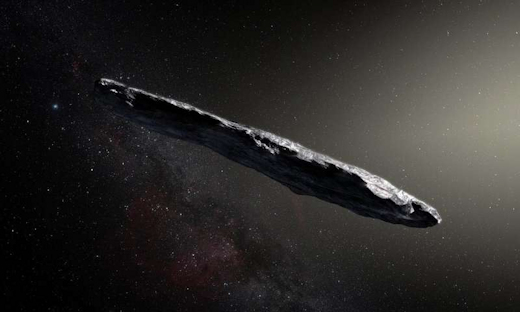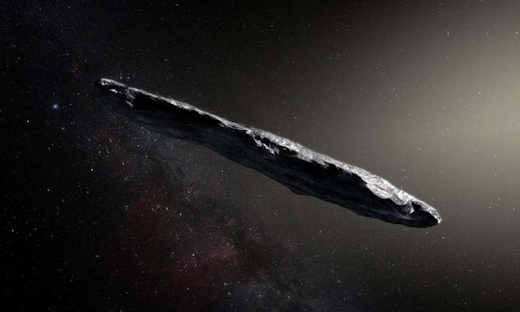It sounds like a tabloid headline, but in this case it could be real.
Mainstream researchers from the Harvard Center for Astrophysics have made the case that interstellar asteroid ‘Oumuamua could in fact be an alien light sail. Their original research was posted Oct. 31st on the moderated preprint server arXiv.org.
The story of ‘Oumuamua begins in October 2017 when it was discovered by Robert Weryk using the Pan-STARRS telescope atop Hawaii’s Haleakalā volcano. Astronomers quickly realized that ‘Oumuamua was something special: The object was hurtling through the Solar System on an unbound “hyperbolic” orbit. It came from the stars. Dramatic changes in the object’s brightness suggested that it was tumbling and asymmetric–thin and wide like a cigar or perhaps a pancake.

Above: This artist’s concept shows how ‘Oumuamua is usually depicted: as a cigar-shaped asteroid.
On its way out of the Solar System, something unexpected happened. ‘Oumuamua accelerated as if jets of gas were pushing it forward. Astronomers who initially thought ‘Oumuamua was an asteroid now turned their attention to the comet hypothesis. Comets naturally develop jets after close approaches to the sun, and such jets could explain ‘Oumuamua’s behavior.
Just one problem: “Despite its close Solar approach of only 0.25 AU (inside the orbit of Mercury), ‘Oumuamua shows no sign of any cometary activity, no cometary tail, nor gas emission/absorption lines,” point out the Harvard researchers Shmuel Baily and Abraham Loeb. Moreover, “if outgassing was responsible for the acceleration, then the associated torques would have driven a rapid evolution in ‘Oumuamua’s spin, incompatible with observations.”
So if it’s not an asteroid, and it’s not a comet, what could it be? Loeb, who is the chair of the astronomy department at Harvard University and also chairs the advisory board for the Breakthrough Starshot light sail project, realized that the acceleration profile was key. The non-gravitational acceleration of ‘Oumuamua scaled with distance from the sun (r) as r-2 — just like a light sail would behave.

Above: The comet hypothesis. Credit: NASA/JPL
Modeling ‘Oumuamua as a thin object pushed by solar radiation pressure, Baily and Loeb found that it would fit the observations if it were a sheet of material 0.3 mm to 0.9 mm in thickness with a mass surface density of ~0.1 grams per square cm. “Although extremely thin, such an object would survive an interstellar travel over Galactic distances of about 5 kiloparsecs, withstanding collisions with gas and dust-grains as well as stresses from rotation and tidal forces,” they wrote.
The researchers are now calling for more observations to look for ‘Oumuamua-like visitors to the Solar System. “A survey for lightsails as technosignatures in the Solar System is warranted, irrespective of whether ‘Oumuamua is one of them,” they conclude.
Source: SpaceWeather.com

































Leave a Comment
You must be logged in to post a comment.